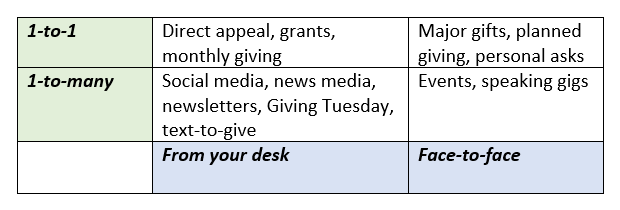
Sometimes, no matter what fundraising strategy you try or how hard you work, you just can’t seem to raise enough money.
It’s like you’ve hit a wall.
What used to work just isn’t productive anymore.
Or what you’ve seen work for others doesn’t work for you.
It’s frustrating and can leave you feeling inadequate, unlucky, or just plain dumb. Yuck.
There are a lot of reasons why it may seem like your nonprofit has stopped moving forward when it comes to fundraising.
While some things DO change and there are new tools on the scene almost every day, most of the problem can be traced back to two things: mindset and fundraising strategy.
Let’s take a look at how these show up in real life and what you can do about it.
The roots of fundraising success: mindset and strategy
Mindset and strategy are both critical to fundraising success and often they’re intertwined.
Mindset is the way you think about things. It’s your view of the world and it’s colored by your beliefs and experiences.
Strategy is your overall approach to a problem and largely determines the tactics you may decide to use.
Unfortunately, many really small nonprofits use one or more fundraising strategies that just don’t work.
| Bad fundraising strategies | Good fundraising strategies |
|---|---|
| Strategy: Build it and they will come
“We’re a 501c3. All we have to do is tell people we’re a nonprofit and they’ll give us money.”
Strategy: Event Hamster Wheel “I don’t have time to plan, so we’ll just do this fundraiser. Then next month we’ll do another fundraiser.”
Strategy: Grant Misunderstanding “There are thousands of foundations out there giving money away to nonprofits. Surely we can get enough to keep our operations running.”
Strategy: GoFundMe “People raise tons of money through crowdsourcing. All we have to do is post on GoFundMe and the money will come pouring in!”
Strategy: Rich people “There’s a bunch of nice houses in ______ neighborhood. Let’s send a letter to those rich people. I bet they’ll give us money.”
Strategy: Hope “I sure hope this works.” |
Strategy: Use donor-based fundraising
-Build a donor base of people who love your nonprofit’s work. -Communicate to keep people in the loop. -Treat them like part of the team. -Share stories to warm their heart. -Ask them to help you change lives. -Give them a good experience so they want to keep giving. -Create an annual fundraising plan including asks, communications, and warm touches. |
Your mindset is there in the background, guiding what you think and what you do. And it’s so automatic that you may not notice as mental habits and routines of thinking are established.
In fact, you may have some mental habits that are interfering with your progress right now.
These bad behaviors take your eyes off the prize, distract you from your mission, and get in the way of the fundraising growth you need to realize your vision.
Worst of all, bad habits can lead to less-than-stellar funding results. Here are 6 of the most common bad habits that show up in struggling nonprofits:
 1. Underestimating what you can do – Are you playing it too safe? Instead of trying something really big, do you stay in “reality” so you don’t fail or disappoint anyone? Are you more committed to your comfort zone than your dreams? It might be time to stretch a little, giving yourself a bigger-than-usual goal to see what you can really do. You might just be downsizing your dreams to match your history, which isn’t the kind of environment that fully funded budgets are grown in.
1. Underestimating what you can do – Are you playing it too safe? Instead of trying something really big, do you stay in “reality” so you don’t fail or disappoint anyone? Are you more committed to your comfort zone than your dreams? It might be time to stretch a little, giving yourself a bigger-than-usual goal to see what you can really do. You might just be downsizing your dreams to match your history, which isn’t the kind of environment that fully funded budgets are grown in.
2. Getting stuck in the status quo – You say “this is the way we do it” or “that won’t work” way too often which limits the time you spend trying something new or giving yourself a chance to succeed outside of your current routines. For example, let’s say your organization helps elderly patients get to their medical appointments, but your roster of volunteers and staff is struggling with the number of patients you already have. Branching out seems impossible, even though you know there’s a much greater need to be filled. You try to work even harder, struggling to keep up, which leaves even less time to work on fundraising and searching for new donors. And that just perpetuates the problem, putting you in a downward spiral.
3. Focusing on “fundraisers” – If your fundraising experience includes a lot of events, product sales, and “fundraisers,” it’s no wonder that’s your go-to when you need cash. The problem is that transactional fundraising (where someone gets something in return for their donation) isn’t sustainable long term. While you’re busy organizing your next event, you don’t have time to do more transformational fundraising, which is much more fruitful both now and into the future. Your fundraising is weighted in the wrong direction and it’s keeping you exhausted and broke.
4. Waiting for success to show up all by itself – Thomas Edison said, “Opportunity is missed by most people because it is dressed in overalls and it looks like work.” The same could be said for getting the word out about your nonprofit. Donors aren’t mind readers. If you have this attitude, you won’t be out there advocating for your cause or figuring out who and where your donors are. Donors can’t find you until you are actively trying to find them. That means you have to think about who you’re looking for and where you can easily find them, then get out of your chair and go talk to them.
5. Not evaluating past successes and failures – If a campaign falls short, do you call in the troops and see what went wrong or do you plow ahead to the next idea, throwing everything at the wall to see what sticks? What about a campaign that was a great success? Do you carefully assess what went right? Do you ask donors what prompted them to give? If you don’t have an evaluation plan in place, you won’t really have a fundraising strategy at all because you don’t really know why anything worked or failed. You will be constantly running from one idea to the next, essentially making planning an effective fundraising strategy impossible.
6. Playing the blame game – Your Board won’t help. Your volunteers don’t show up. The people in your community don’t understand the importance of your mission. Donors aren’t giving enough. All those things may be true, but you can’t change how they do things, you can only change how you interact with them. If your attitude is one of blame, you will constantly be waiting on someone else to change before you can move forward. This leads to frustration, chronic grouchiness, and even less help from the people around you, not more. The blame game is you-centric not donor-centric and the first person you need to confront is the one in the mirror.
Can you start to see how your mindset, mental habits, and negative attitudes impact your fundraising and your nonprofit’s ability to grow?
The negative thinking keeps you stuck, right where you are, making it feel like nothing is working.
And it’s not. Your campaigns are off target, your appeals are dry, and your donors are turned off.
Okay, now that you’re aware of the mindset part of the problem, you can start to fix it. (The first step in any good 12 step program is acknowledging you have a problem.)
And you’ll need an open mind if you want to develop and use a better fundraising strategy so you can raise more money and do more good in the world.
The one fundraising strategy you need for serious growth
Here’s the truth: You can create the kind of revenue you need to easily fund your nonprofit’s good work!
Instead of feeling stuck, you can blow past last year’s budget, motivate staff volunteers and donors, and fulfill not just your current mission but your long-term vision.
In short, you need a new fundraising strategy supported by a new attitude.
And the best fundraising strategy you can implement is donor-based fundraising.
Donor-based fundraising is about targeting the right people with the right message at the right time. It’s about seeing donors as valued partners in your work and valuing them more than their donation.
It requires a shift in thinking and attitude, especially if you’ve been engaging in bad fundraising strategies.
Here are 6 keys to making this change, putting donor-based fundraising in place:
 1. Nurture donor relationships. Are you taking donors for granted? You already know that they share your passion because they’re giving you money to make change in the world. Share with them the happy endings their donations have made possible. Let them know they are making the world a better place by communicating with them between asks. You may worry about donor fatigue, but you can ask for donations as often as you want as long as the donor gets 3 good, meaningful communications between asks. Donors might get a powerful thank you letter, a thank you call, a holiday card, or even an update video to show them how much they are appreciated. The important thing is that you care more about the person than their money and you show it regularly.
1. Nurture donor relationships. Are you taking donors for granted? You already know that they share your passion because they’re giving you money to make change in the world. Share with them the happy endings their donations have made possible. Let them know they are making the world a better place by communicating with them between asks. You may worry about donor fatigue, but you can ask for donations as often as you want as long as the donor gets 3 good, meaningful communications between asks. Donors might get a powerful thank you letter, a thank you call, a holiday card, or even an update video to show them how much they are appreciated. The important thing is that you care more about the person than their money and you show it regularly.
2. Communicate in a donor-centric way. Many of the bad behaviors that lead to stagnation – like the blame game and waiting on success instead of being proactive – start when you get so busy that you lose site of what’s important and start treating donors like they’re just a number in your database. Your goal should be building a big base of loyal donors. No matter how you choose to ask for donations, whether one-to-one or en masse, think about things from your donor’s perspective:
- Keep the appeal personal, even if you’re sending it to lots of people.
- Lead with a story. Donors want to be involved in a narrative, not be a statistic in a chart, and they truly want to make a difference. Telling a story establishes the emotional connection donors need to get involved.
- Let the donors know exactly how their contributions will make a difference. “For $12, you can give a dog food and a bed for a week at a foster home.” Let your donor know exactly what the impact will be when they give.
- Keep your appeals jargon free. Jargon takes mental effort to understand and your potential donor will be busy reading someone else’s post before they get to the end of the third sentence! Leave out the acronyms, technical language and insider slang.
- Use video when possible. People are inundated with messages online and on social media. Video does a better job of catching the eye and a well-done video tells the story much better than a paragraph can.
- Make it easy to give. Your donor should be able to give with a minimal amount of effort. If you ask for donations online, consider one-click donations. If you’re speaking to a group, make sure you can take donations on the spot. Always think about making it easy for the donor to give.
- If you’re asking a major donor for a gift face-to-face, be prepared to clearly explain your vision, the numbers, and the impact. Connect the dots for the donor between their interests, your needs, and the lives changed.
3. Diversify your funding. As you think about how you’ll raise money for the year, keep in mind that a broad funding base provides stability. Relying on one source of revenue is like trying to sit on a one-legged stool – it WILL fall over. If your nonprofit is new, build your donor base and use a combination of appeals, monthly giving, and a signature event to raise money. As your nonprofit grows, add grants, major gifts, and planned gifts to the mix. When you have strong revenue streams from several sources, you can handle it if one of them decreases sharply or disappears.
4. Get face time with donors. Sometimes it’s easy to get stuck in a rut using the same few fundraising strategies over and over. It’s like you’re on some kind of fundraising treadmill. If you’re an introverted fundraiser, it’s easy to find things to do from your desk so you don’t have to be around people.
However, some of the most productive fundraising activities require you to meet people face-to-face. A few hours spent cultivating a donor can bring big rewards compared to the hundreds of hours it takes to plan and host an event that may not bring in nearly the same revenue.
Have a look at the chart below to see where you’re spending most of your time.

Many directors spend their time in the left side of the chart, sending out the same old newsletters and direct appeals to the same old people each year and surprise, surprise the same old thing happens.
Of course, there’s nothing wrong with newsletters and direct appeals. Done right, these can bring in a lot of donations. But the same amount of time spent with someone who loves your cause can bring you big donations, additional connections, and opportunities you can’t yet imagine. Your donor may get so excited about the work your nonprofit is doing that she wants to introduce you to all her friends, especially the one who sits on the Board of a local foundation.
Face time with individual donors doesn’t have to be hard or nerve-wracking. Start with something easy like inviting a major donor prospect to visit your facility for a personal tour. This is a great way to share your vision with someone who can make a big impact and hear what part of your mission warms their heart. There are plenty of donors out there who want to see a transformation! They want to help change lives. Even if this is outside your comfort zone, just try it. You might find out that your donors are very nice people who are easy to talk to.
On the other hand, if you rely on a few major donors, ask yourself if you have enough small monthly donors. There may be plenty of people who want to help but can’t afford to write a big check all at once, preferring to spread it out in monthly installments.
Honestly, it takes all donors – big ones, little ones, monthly ones, sporadic ones, ones you like, and ones you don’t – to fully fund your organization’s budget. If you’re open to adding new opportunities for people to give and you’re strategic as you plan and implement, you’ll see amazing things happen!
 5. Evaluate successes and failures. It’s easy to rush from one thing to the next, especially when you’re busy, but successful nonprofits take time to carefully assess what worked and what didn’t. It may feel like looking backwards when you just want to zoom ahead but assessment is part of a growth-oriented fundraising strategy. Did the story you posted in your blog bring in more donations than usual? What was special about it? How can you tell more of these stories? What about things that didn’t work? Did they cost more in time and money than they brought in? You should always be evaluating and tweaking activities for maximum effect. A consistent, systematic way of evaluating your success will lead to better planning, new ideas, and more donations.
5. Evaluate successes and failures. It’s easy to rush from one thing to the next, especially when you’re busy, but successful nonprofits take time to carefully assess what worked and what didn’t. It may feel like looking backwards when you just want to zoom ahead but assessment is part of a growth-oriented fundraising strategy. Did the story you posted in your blog bring in more donations than usual? What was special about it? How can you tell more of these stories? What about things that didn’t work? Did they cost more in time and money than they brought in? You should always be evaluating and tweaking activities for maximum effect. A consistent, systematic way of evaluating your success will lead to better planning, new ideas, and more donations.
6. Learn something new. Most people who start nonprofits have a dream about helping others and making the world a better place. They didn’t start out thinking how much fun it would be to spend their days asking for money. Frustration and the feeling that you’re not good at fundraising can lead to stagnation. Invest time and money in learning opportunities so you can get better at talking to people and asking for money. Go to conferences. Meet with experts, consultants, and other nonprofit administrators. The point is you must sharpen the saw if you want to continue to be effective.
The Bottom Line
The definition of insanity is doing the same thing over and over and expecting different results.
If you aren’t seeing increases in the amount of money you’re raising, it may be time to hit the pause button and have a look at what’s going on, both in your fundraising strategy and in your mindset.
Embrace donor-based fundraising and value your donors like the assets they are. And pretty soon, you’ll see your fundraising results start to soar!
Additional resources
5 Ways to Turn Around Your Stagnant Nonprofit https://www.marylandnonprofits.org/5-ways-to-turn-around-your-stagnant-nonprofit/5 Ways to Turn Around Your Stagnant Nonprofit
Want more help learning to raise support for your new, young, or small nonprofit? Join us for Fundraising Breakthrough, a 4-part online video workshop where you’ll learn how to find donors who already love your mission, what to say to get them to give, and how to build relationships so donors are ready to give whenever you ask. It’s FREE so join us! Register here: GetFullyFunded.com/Breakthrough






Leave A Comment